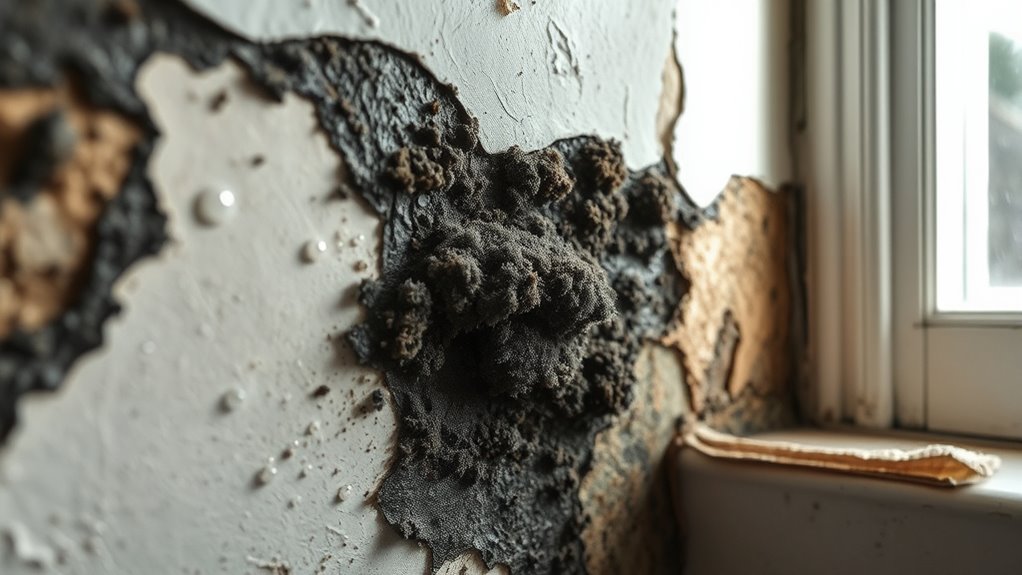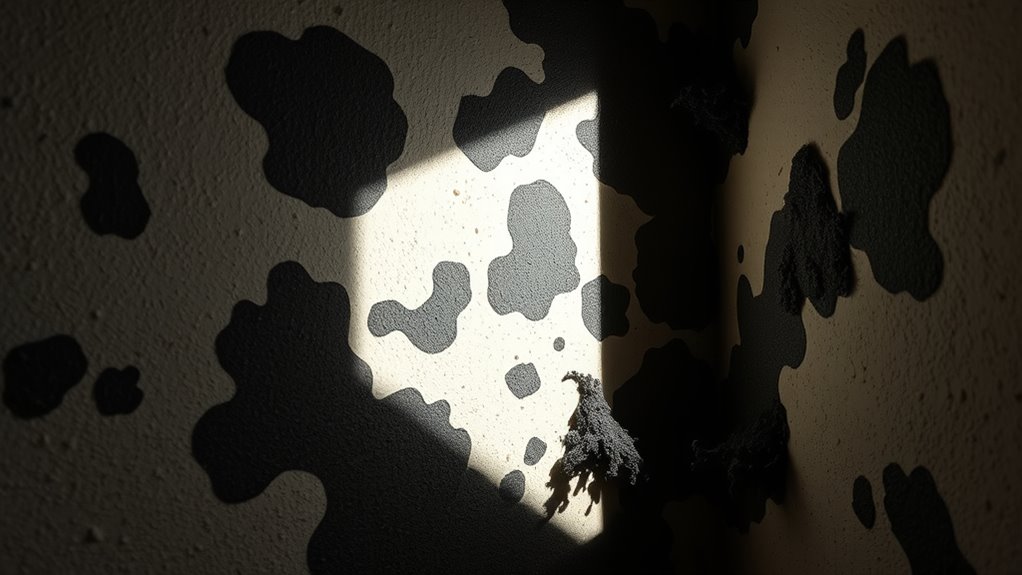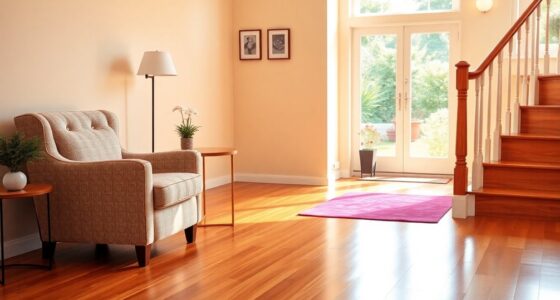To keep dampness from harming your health, start by watching for signs like musty odors, visible mold patches, or stains on walls and ceilings. Look out for hidden moisture in places like under sinks, behind toilets, or in basements, and use your senses to detect dampness or smells. Fix leaks promptly and maintain good ventilation to prevent mold growth. If you want to stay ahead of hidden threats, there’s more to uncover beyond what you see.
Key Takeaways
- Regularly inspect your home for visible mold, discoloration, or fuzzy patches, especially in damp areas like bathrooms and basements.
- Detect musty odors early, which can indicate hidden mold growth and ongoing moisture issues.
- Monitor for water stains, peeling paint, or warped materials that signal persistent dampness.
- Use your senses—smell, sight, and touch—to identify damp spots and potential mold hotspots.
- Maintain proper ventilation and promptly fix leaks to prevent moisture buildup and mold development.

Have you ever wondered how to spot mold in your home before it becomes a bigger problem? Recognizing the signs early can save you time, money, and, most importantly, your health. Mold often hides in plain sight, thriving in damp, dark areas where you might not immediately look. To catch it early, start by paying close attention to your environment. If you notice a persistent musty smell, that’s often a telltale sign mold is present, even if you can’t see it. This odor results from mold spores releasing volatile organic compounds, which can permeate walls, furniture, and fabrics.
Early mold signs include musty odors and hidden damp spots.
Next, visually inspect common trouble spots. Bathrooms are prime locations because of high humidity levels. Look around shower stalls, tubs, and sinks for any discoloration or fuzzy patches—these are often mold colonies. Don’t forget to check behind and under toilets, sinks, or cabinets where moisture can collect unnoticed. In the kitchen, keep an eye on beneath the sink and around appliances like dishwashers or refrigerators, which can leak and create ideal conditions for mold growth. Basements and crawl spaces are also hotspots, especially if they are poorly ventilated or have water intrusion issues. Look for any staining, peeling paint, or warped materials, which could indicate moisture problems and potential mold growth.
Your windows and window frames are another common place for mold to develop, especially if condensation builds up overnight. If you see black, green, or brown spots on these surfaces, it’s time to investigate further. Pay attention to any recurring condensation or water stains, as these suggest persistent moisture issues that can foster mold growth over time. Even small leaks or drips, if left unaddressed, can lead to bigger mold problems before you realize it.
To stay vigilant, use your senses. Besides sight and smell, feel for any areas that are damp or sticky to the touch, especially on walls, ceilings, or fabrics. Regularly check for water damage signs like bubbling paint, stained drywall, or warped wood. The sooner you notice these clues, the easier it will be to tackle mold before it spreads extensively. Remember, mold can be hidden beneath surfaces or inside walls, so if you suspect hidden mold, consider professional inspections. Being proactive in identifying these early signs keeps dampness from turning into a health hazard, ensuring your living space remains safe and mold-free. Additionally, understanding that high contrast ratios can help you better assess the severity of visual problems caused by moisture or mold-related discoloration can improve your inspection process.
Frequently Asked Questions
How Can I Detect Hidden Mold Behind Walls?
You can detect hidden mold behind walls by looking for signs like a musty smell, discolored patches, or peeling paint. Use a moisture meter to identify damp spots and consider hiring a professional for mold testing or inspection. Keep an eye on areas prone to leaks, such as around pipes or windows. If you suspect mold, address the moisture source immediately to prevent it from spreading further.
Are All Types of Mold Equally Harmful?
Not all molds are equally harmful. Some, like black mold, can cause serious health issues such as respiratory problems and allergies, while others are less dangerous. You should be cautious with any mold growth, especially if you notice a musty smell or see visible colonies. It’s best to have a professional assess your situation since some molds produce toxins, and proper removal is essential for your health.
What Are Natural Methods to Prevent Mold Growth?
Did you know mold spores can spread through the air within 48 hours? To naturally prevent mold growth, keep your home well-ventilated and control humidity levels below 60%. Use moisture-absorbing plants like Boston ferns and keep surfaces dry. Regularly fix leaks and clean with vinegar or baking soda. These simple steps help reduce dampness, making your home less inviting to mold.
Can Mold Exposure Cause Long-Term Health Issues?
Yes, mold exposure can cause long-term health issues. You might experience respiratory problems, persistent coughing, or worsened asthma symptoms. In some cases, extended exposure can lead to chronic sinus infections or even neurological issues. It’s important to address mold problems quickly and limit your contact with mold spores. Regularly ventilate your home, fix leaks promptly, and consider professional mold testing if you notice persistent symptoms.
How Often Should I Inspect My Home for Mold?
You should inspect your home for mold at least once a month, especially in humid or damp areas like bathrooms and basements. Coincidentally, whenever you notice a musty smell or visible water damage, it’s time to check even more frequently. Regular inspections help catch mold early, preventing health issues and costly repairs. Stay vigilant, and don’t forget to dry out any leaks or spills promptly to keep mold at bay.
Conclusion
By staying vigilant and controlling moisture, you can prevent mold from sneaking into your home like an unwelcome guest. Regular checks and quick repairs are your best defense against dampness that threatens your health. Remember, mold is like a shadow—if you ignore it, it’ll grow and take over. Stay proactive, keep your environment dry, and protect your well-being. Your health is worth the effort; don’t let mold steal it away.









